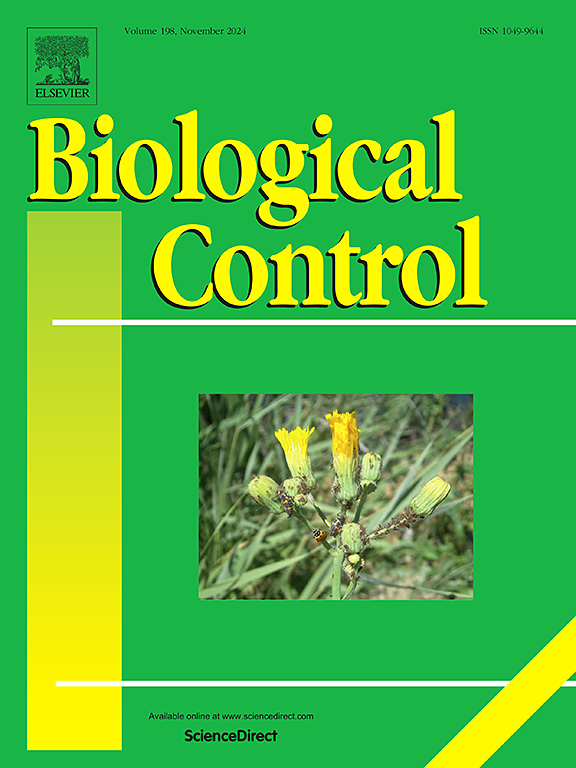Versatile role of Bacillus velezensis: Biocontrol of Fusarium poae and wireworms and barley plant growth promotion
IF 3.4
2区 农林科学
Q2 BIOTECHNOLOGY & APPLIED MICROBIOLOGY
引用次数: 0
Abstract
The major losses in cereal production are most commonly caused by phytopathogenic fungi and insect larvae, indicating the need for sustainable pest control management. Although bacterial bioinoculants offer an eco-friendly alternative for plant protection and growth promotion (PGP), their effects on Fusaium poae and Agriotes lineatus larvae have not been comprehensively studied yet. To find an effective biological control agent against these pests, Bacillus strains were isolated from soil and tested for PGP and biocontrol traits, including the presence of antibiotic and toxin-coding genes. Out of eleven strains, B. velezensis BHC 5.6 showed a wide range of PGP and biocontrol abilities, while the presence of fenD, bmyB, srfAA, spaS genes was also detected. Only two strains, P. megaterium BHC 5.5 and B. velezensis BHC 5.6, showed antifungal effect against F. poae with inhibition percentage of 62% and 67%, respectively. The highest insecticidal effect against wireworms was recorded for B. velezensis BHC 5.6 (56.67%) and B. safensis BHC 11.4 (43.33%). The PGP activity of B. velezensis BHC 5.6 was also confirmed in a pot experiment, where an increment of barley yield was recorded both for infected (17.09%) and uninfected barley seeds (10.12%). This is the first time demonstrating that the B. velezensis BHC 5.6 could be used for integrated pest management of F. poae and A. lineatus larvae in barley and for plant growth promoting. Therefore, the implementation of this strain could contribute to the food safety in sustainable agricultural practices.
velezensis的多功能作用:防治稻枯萎病和线虫,促进大麦植株生长
谷物生产的主要损失通常是由植物病原真菌和昆虫幼虫造成的,这表明需要可持续的虫害防治管理。虽然细菌生物接种剂为植物保护和生长促进(PGP)提供了一种生态友好的替代方案,但其对镰刀菌(Fusaium poae)和线线虫(Agriotes lineatus)幼虫的影响尚未得到全面研究。为了寻找有效的生物防治剂,从土壤中分离芽孢杆菌菌株,检测其PGP和生物防治性状,包括抗生素和毒素编码基因的存在。在11株菌株中,贝氏贝氏杆菌BHC 5.6具有广泛的PGP和生物防治能力,同时还检测到bmyB、srfAA、spaS等基因。只有2株病原菌megaterium BHC 5.5和B. velezensis BHC 5.6具有抑菌作用,抑菌率分别为62%和67%。对线虫的杀虫效果最高的是白僵菌BHC 5.6(56.67%)和白僵菌BHC 11.4(43.33%)。盆栽试验也证实了B. velezensis BHC 5.6的PGP活性,感染和未感染的大麦种子的产量均增加了17.09%,未感染的大麦种子的产量均增加了10.12%。这是第一次证明白僵菌bhc5.6可用于大麦中白僵菌和线僵菌幼虫的综合治理和促进植物生长。因此,该菌株的应用可促进可持续农业实践中的食品安全。
本文章由计算机程序翻译,如有差异,请以英文原文为准。
求助全文
约1分钟内获得全文
求助全文
来源期刊

Biological Control
生物-昆虫学
CiteScore
7.40
自引率
7.10%
发文量
220
审稿时长
63 days
期刊介绍:
Biological control is an environmentally sound and effective means of reducing or mitigating pests and pest effects through the use of natural enemies. The aim of Biological Control is to promote this science and technology through publication of original research articles and reviews of research and theory. The journal devotes a section to reports on biotechnologies dealing with the elucidation and use of genes or gene products for the enhancement of biological control agents.
The journal encompasses biological control of viral, microbial, nematode, insect, mite, weed, and vertebrate pests in agriculture, aquatic, forest, natural resource, stored product, and urban environments. Biological control of arthropod pests of human and domestic animals is also included. Ecological, molecular, and biotechnological approaches to the understanding of biological control are welcome.
 求助内容:
求助内容: 应助结果提醒方式:
应助结果提醒方式:


